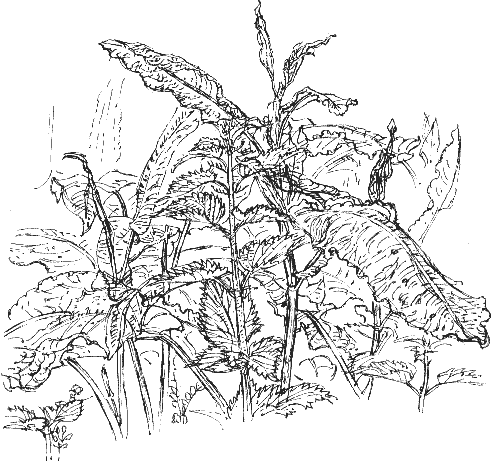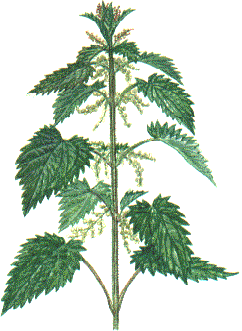Docks and NettlesMonday, 2nd June 2003, West Yorkshire |
![]()
![]()
![]()
![]() Rocks | History |
Workshop |
Links | Home
Page
Rocks | History |
Workshop |
Links | Home
Page
![]()

Honestly, some day I'll get over this stage of wanting to draw tangled vegetation in pen and ink.
![]()
![]()
This pen, an old Rotring Art Pen (a fountain pen) with a fine sketch nib, seems to have worn itself in so that it does just about what my hand and eye want it to do. It's become an extension of my hand/eye.
I'm very interested, obsessed might not be too strong a word, in SEEING at the moment, rather than in picture-making or in illustrating some aspect of nature. That's what I trained to do at art college - natural history illustration - but there's a difference between that and just plain seeing.
 In
natural history illustration (such as my watercolour of the nettle,
left, for An Illustrated Guide to Herbs by Anna Kruger, 1992,
© Dragon's World) you try to explain a subject to some extent.
You might emphasise, in a sophisticated and subtle way of course, the
botanical details of flower, stem and leaf joint. In fact my nettle watercolour
is a bit on the fuzzy side for traditional botanical illustration. You
might depict an animal in a particular habitat to suggest the story of
its place in the local ecology.
In
natural history illustration (such as my watercolour of the nettle,
left, for An Illustrated Guide to Herbs by Anna Kruger, 1992,
© Dragon's World) you try to explain a subject to some extent.
You might emphasise, in a sophisticated and subtle way of course, the
botanical details of flower, stem and leaf joint. In fact my nettle watercolour
is a bit on the fuzzy side for traditional botanical illustration. You
might depict an animal in a particular habitat to suggest the story of
its place in the local ecology.
My pen and ink drawing above is a bit different. I'm not trying to tell a story about these nettles and docks (although all kinds of connections got through my mind as I'm drawing). I'm trying just to see, without preconceptions, if that's possible with my background in natural history, the physical appearance of these particular plants.
Dock Leaves
I like the structure of the dock, the way it unfolds, the way it holds its top leaves up in a gesture of supplication, while its lower leaves relax in a gesture of resignation.
![]()
![]() It's
a plant that 'knows' how to get on in the world: those top crimped, tightly
curled leaves snake up above the surrounding plants like a cobra emerging
from a snake-charmer's basket, then they spread out, like the cobra spreading
the fringes on its neck, and shade out the competing vegetation below.
It's
a plant that 'knows' how to get on in the world: those top crimped, tightly
curled leaves snake up above the surrounding plants like a cobra emerging
from a snake-charmer's basket, then they spread out, like the cobra spreading
the fringes on its neck, and shade out the competing vegetation below.
As they flourish the leaves have luxuriant wavy edges, like the rhubarb I was drawing the other week. They're flouncy and foppish compared with the restrained elegance of the elongated heart-shaped nettle leaves with their heraldically crisp saw-toothed edges.
The leaves of the dock go from young and vigorous at the top to showy opulence halfway up and finally to a relaxed, floppy and blotched maturity, resting on a bed of foliage, surrounded by a crowd of younger, more vigorous buttercups and bush vetches that still have a lot of get-up-and-go.
Doesn't that happen to all of us?! I know just how they feel. If you really see and draw you start to feel that what you are drawing has ceased to be an object. You feel the way the plant unfurls, flourishes and falls. It's not the same dispassionate accuracy of depiction that you need to produce a decent botanical illustration, where you need to keep an objective detachment from the object you're describing.
When you're seeing/drawing (as Frederick Franck describes the process in The Zen of Seeing) in some ways you become that leaf as it unfurls, matures and declines.
As George Orwell put it, in Coming up for Air, 'I was looking at the field, and the field was looking at me.'
![]()
![]()
I'm well aware that my drawing lacks the organic vigour of the real vegetation as it jostles and shakes and intertwines in the breeze. I took a couple of hours to draw it, which is rather a long time for such a simple subject, but I was more concerned to see the subject and attempt to get things right in my drawing than I was to produce a springy, energetic drawing.
Hopefully that will come later.
![]()
![]() Next page | Previous
page | This
day last year | This month |
Nature Diary |
Home
Page
Next page | Previous
page | This
day last year | This month |
Nature Diary |
Home
Page
![]()